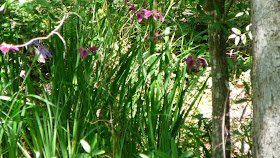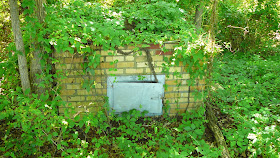by Ron Killingsworth
 |
| Ron Killingsworth standing in a clump of irises growing at the edge of Cross Lake just north of Shreveport, LA |
Of course Louisiana irises grow wild in the wilds of Louisiana! Especially in south Louisiana: in fact, they grow in the ditches down south. Not many grow wild in the northwestern part of the state, though.
Several years ago a dear friend who lived in north Shreveport, LA, very near Cross Lake, called to tell me she had found some Louisiana irises growing in the wild in the backwaters of Cross Lake. Cross Lake is a man-made lake that supplies the water for the city of Shreveport. Sue and I put on our boots and joined our friend Lin Millar and we went deep into the woods behind her home into an area of overflow for the lake. It appears to have been an old home site at one time.
We found many Louisiana irises blooming in the marshy lowlands. Most of them appeared to be species irises as the blooms were not as large or well developed as most hybrid Louisiana irises. We found many different colors but none of us are scientists so we were not able to determine if they are species or if so, which ones.
All of these irises were growing in areas that were either still standing in water or that would have been in water when the lake was higher. Almost all of them were growing in very shaded areas that would have given them very little sunshine. This probably explains why most of them had few blooms per bloom stalk.
We carefully collected samples of each of the irises we found and took them back to Lin's garden and to our gardens in Mooringsport, LA. I now grow them in a large bed labeled "Cross Lake Irises". They are doing fine in their new location. Lin visited the area a couple of years later and the whole area had been clear cut and plowed up as though someone was getting ready to build a home there.
When collecting irises growing in the wild we must certainly be careful to leave more than we take. In this case, it is certainly a good thing we collected some of each as they are now gone!
Some of our readers may be able to classify these irises from the pictures but it is beyond my ability. I know that these pictures prove that Louisiana irises are pretty hardy and will grow in undergrowth, bushes and without full sunlight.
This was an exceptionally beautiful specimen with a great color.
The above picture shows an area in which the irises were growing well although they were quite removed from the lake edge. These were receiving more sunlight than most we found.
This is another area that was at least 50 feet from the lake edge and thick with weeds and grass.
These irises were growing in the water at the lake's edge. (Lin's dog, part Labrador, really enjoyed the "field trip".)
More irises growing in the lake's edge in an area that is very swampy and a perfect place for snake watching.
This was found very close nearby so it appears the area once had a home. There were many people growing Louisiana irises in their gardens in the Shreveport area in the 40's and 50's, so I believe these irises were either planted in the area or escaped from other gardens around Cross Lake. They may even be from seeds from irises grown in gardens around the lake. We used to cut off all the seed pods from our thousands of Louisiana irises and throw them into Caddo Lake hoping they would take root on the side of the lake.
Do you know of a spot where irises grow wild? Perhaps a nearby cemetery, or an old abandoned farmstead?
If you would like to learn more about Louisiana irises you can visit the Society for Louisiana Irises, and more about all species of irises is available at the website of The American Iris Society.























